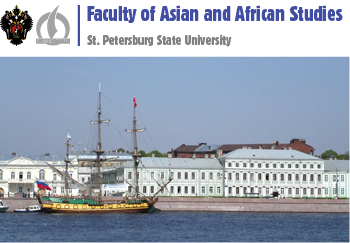St Petersburg University expands ties with Japan Youth Chamber
St Petersburg University expands ties with Japan Youth Chamber
The delegation of the Youth Chamber of Japan has visited St Petersburg University. During the visit, a student seminar was held and a cooperation agreement was signed.
The programme of the visit of the foreign guests started with an international seminar on Russian-Japanese relations. Associate Professor Mariya Malashevskaya (Department of Theory of Social Development in Asia and Africa) conducted an excursion into the history of interstate relations for students of St Petersburg University and their foreign colleagues. In her lecture she cited historical plots illustrating the successful interaction of the two countries over the course of three centuries.
The first contacts were established as early as the beginning of the 18th century — with the arrival in Russia of a Japanese man called Dembey. He became the first teacher of the Japanese language school which opened in St Petersburg in 1705. One hundred years later, in 1808, the first Russian language school was opened in Nagasaki. The official establishment of diplomatic relations took place in 1855 - with the signing of the Treaty of Shimoda.
Mariya Malashevskaya also presented to the participants of the meeting a model of the three levels of dialogue between the countries. According to it, interstate partnership is conducted at the macro level, regional interaction at the meso-level, and the activity of individual citizens at the micro level. A striking example of partnership at the global level is the holding in 2018 of the Cross Year of Russia and Japan, which initiated more than a hundred events in various fields that are designed to expand peoples' perceptions of each other.
The opening of a Japanese office in St Petersburg University in March 2018 was timed to coincide with the exchange year of Russia and Japan. We also recall that in 2017, Japan became the guest country of the VI St Petersburg International Cultural Forum.
The maintenance of regional ties is nevertheless of state importance. So, in August of this year, the official delegation of St Petersburg visited the centre of Hokkaido Prefecture - the city of Sapporo, where the heads of the regions concluded a cooperation agreement. During this visit, a memorandum of St Petersburg St University was signed with the Medical University of Sapporo (Hokkaido Prefecture), designed to establish academic and humanitarian exchanges in the scientific and research fields. In 2019, St Petersburg will celebrate the fortieth anniversary of establishing twin-city relations with the capital of Osaka Prefecture.
In autumn of 2017, Numano Kyoko, a Professor at the Tokyo University of International Studies, spoke about the influence of Japanese culture on Russian writers and artists of the twentieth century to students.
“The most curious, in my opinion, is civil interaction - at people’s level. In international relations, it is called “second level diplomacy,” said Mariya Malashevskaya. “An illustration of such diplomacy is the works of the artist Varvara Bubnova, who lived in Japan for more than 30 years. Bubnova became the “bridge” between Russian and Japanese culture. She taught Russian language and literature in a number of Japanese universities, translated Russian classics, and organised several exhibitions of Soviet art. And for Russia and the West, she has become a valuable source of knowledge about traditional Japanese culture”.
Another example of public diplomacy is the work of writers Akira Kumano and Masahiko Shimada, who revealed to the Japanese reader the culture of modern Russia and its contemporary history. “Both authors are very familiar with the daily life of our country and the Russian mentality. They tried to embody the corresponding images in their novels”, said Mariya Malashevskaya. “In the book “Love on Iturup” Shimada spells the idea that love is the only possible bridge capable of establishing good relations between the two countries”.
In 2017, the Japanese writer Masahiko Shimada visited St Petersburg University, where he conducted an open lecture on artificial intelligence.
Interaction at the local level is also well illustrated by cultural and educational events that St Petersburgers are trying to reveal various aspects of the life of the Land of the Rising Sun. Mariya Malashevskaya noted that she herself often gives lectures in St Petersburg about the life of Japanese society. She gave the participants of the seminar a task to divide into teams in order to discuss other possible steps aimed at strengthening interstate relations.
During the visit of the Japanese guests, Deputy Rector for International Affairs Sergey Andryushin and the President of the organisation Masaoki Fukui signed a cooperation agreement between St Petersburg University and the Youth Chamber of Japan. The document recorded the existing partnership, in which students can travel to Japan under the programme of short-term study visits. The agreement was signed in accordance with the university plan of events of the exchange year of Russia and Japan.
The ceremony was attended by Deputy Consul General of Japan in St Petersburg Hideto Watanabe. He noted the value of the treaty for the development of interstate relations and stressed that the Consulate General supports the initiatives of the Chamber in terms of humanitarian exchanges and increased mutual understanding between young people from the two countries.
The programme, according to which young people from Russia visit Japan first and then accept Japanese colleagues, has been implemented by the organisation for 12 years. This summer, four university students participated in the project. “We visited the Russian offices in Osaka, the Russian military cemetery in Nagasaki and the Russian embassy in Tokyo,” said a programme participant, philologist Artemiy Kuznetsov. “This trip helped me make a lot of new friends in Japan. It is very likely that my professional life will be closely connected with this country: I plan to study Japanese grammar, so I will return to Japan to conduct field research and to participate in conferences”.
https://orient.spbu.ru/en/all-news/all-news/all-news-archive/871-st-petersburg-university-expands-ties-with-japan-youth-chamber.html#sigProId7e9d9496cc
- Category: News
- Hits: 2257





